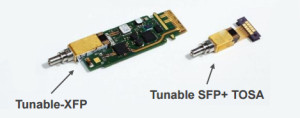 Over the last 10 years the adoption of tunable based solutions has grown significantly. Particularly in the recent years, tunable transceivers are becoming more and more widely used in DWDM transmission systems. The most significant difference between tunable transceivers and ordinary transceivers are the laser. As we know, the early DWDM systems used fixed-wavelength lasers as light sources, which meant that many kinds of optical transceivers were needed for the wavelength channels. However, the use of tunable lasers, which can operate at any channel wavelength, means that only one kind of transceiver is needed, so the inventory cost can be reduced. As the core of tunable transceiver modules, tunable laser plays an very important role in tunable transceiver. Today, we are going to learn and further understand the tunable laser.
Over the last 10 years the adoption of tunable based solutions has grown significantly. Particularly in the recent years, tunable transceivers are becoming more and more widely used in DWDM transmission systems. The most significant difference between tunable transceivers and ordinary transceivers are the laser. As we know, the early DWDM systems used fixed-wavelength lasers as light sources, which meant that many kinds of optical transceivers were needed for the wavelength channels. However, the use of tunable lasers, which can operate at any channel wavelength, means that only one kind of transceiver is needed, so the inventory cost can be reduced. As the core of tunable transceiver modules, tunable laser plays an very important role in tunable transceiver. Today, we are going to learn and further understand the tunable laser.
A tunable laser is a laser the output wavelength of which can be tuned or adjusted, i.e. wavelength tuning. Lasers that are tunable over multiple wavelengths, and progressively over the whole C-band appeared at the beginning of the last decade. They soon became widely used in DWDM systems since they allowed the reduction of different line card or transceiver, which was needed for every different wavelength. Together with ROADM (reconfigurable add drop multiplexers), they became the core of the optical transport systems.
Various kinds of tunable lasers have been developed in the last 10 years, and their performance has been greatly improved. A tunable laser consists of a semiconductor gain region and a wavelength-tunable optical filter. The wavelength is tuned by changing the filter wavelength. Tunable lasers are classified into three structural types: distributed feedback (DFB) laser array, distributed Bragg reflector (DBR) laser and external cavity laser. All of these laser structures provide a tuning range of more than 35 nm, which is required for DWDM systems.

DFB and DBR lasers can be considered as first-generation tunable lasers, because they can be configured to two or possibly four different wavelengths. However, tunable laser modules can transmit many wavelengths across a wide spectrum as compared to the DFB and DBR lasers widely used today. DFB arrayed lasers have their tuning range limited by the number of elements in the array and require 1 to 10 milliseconds (ms) of tuning time. Nowadays, people have reduced the spectral linewidth of DFB laser to make it applicable to 100G systems.
External cavity tunable lasers include collimating optics, mirrors, and an external grating. Commercial external cavity tunable laser modules also include an integrated thermal tuner, a gain chip, an isolator, and a number of flexures that precisely align the laser to the fiber before it is mounted in the package. For example, external cavity lasers with thermally tunable silicon etalon filters have been commercialized for use in tunable transceivers. External cavity tunable lasers have a typical output power in excess of 20 milliwatts (mW). Generally, the more widely tunable the laser, the less its transmit power. Newer DWDM systems are being designed with external cavity tunable lasers. External cavity tunable lasers can switch from one wavelength to another in the order of nanoseconds, and this makes them potential candidates for building optical switched that could route traffic on a wavelength basis.
At present, the market of 10G tunable transceivers, e.g. tunable DWDM XFP and SFP+ have already been very mature. The next step is to develop a higher-performance tunable transceiver to satisfy the 100G systems. As the core of tunable transceivers, tunable laser requires higher power, a wider tuning range, and lower power consumption. In addition, the package of the next generation tunable transceivers must be more and more compact to meet the aggregation switches. In all, research and development will continue with the aim of obtaining tunable lasers and tunable transceivers with even better performance.



